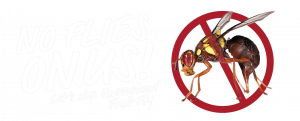This information has been commissioned by the Goulburn Murray Valley Fruit Fly Area Wide Management Project and is funded by the Victorian Government’s Managing Fruit Fly Regional Grants Program. Use of this material in its complete and original format, acknowledging its source, is permitted, however unauthorised alterations to the text or content is not permitted.
Population update
The December increase in Queensland fruit fly numbers represented the start of the new season’s fruit fly population which, if not controlled, will explode to large numbers in February – April 2021 and cause significant damage to fruit.
Increases in fruit fly populations is of particular concern this year due to the impact of the current La Niña weather pattern occurring in much of South Eastern Australia. Higher levels of rainfall and associated increases in ambient relative humidity and fruit set, as a result of La Niña, are favourable to fruit fly population expansion.
Examination of December trapping figures identified that only a few traps on the Goulburn Murray Valley trapping grid are major contributors to increased Queensland fruit fly populations. These locations are known as fruit fly ‘hot spots’ from which new populations will, if not managed, spread further afield later in the season.
Hot spot locations include:
- 1 site in Nagambie
- 1 site in Numurkah
- 4 sites in Euroa
- 2 sites in Shepparton
- 1 site in Mooroopna
- 1 site in Kyabram
All the above sites are in urban situations.
These sites cover a great deal of the region and if fruit fly in these spots are not managed effectively they will spread from these sites into the rest of the region immediately surrounding them. Newer generations will emerge from these flies and spread, in a ripple effect, further out into nearby commercial crops in autumn, as commercial crops in the region ripen.
Figures for Cobram urban and Cobram rural traps are not included in this report as current data from these traps are a mixture of wild Queensland fruit fly and sterile Queensland fruit fly. This occurrence is due to the SITplus Pilot Project which uses the sterile insect technique to control fruit fly.
January outlook
Queensland fruit fly trap capture rates are expected to increase into January 2021 as they follow the same annual pattern since trapping commenced in the Goulburn Murray Valley in 2012.
If night time maximum temperatures and rainfall are higher due to the effect of La Niña, increased soil moisture and humidity will increase micro bacterial growth, creating another protein food source for female fruit fly’s. If not managed, this will contribute to increased fruit fly numbers.
Data and weather outlook received from the Bureau of Meteorology website weather outlook for January 2021 (accessed 23 December 2020).
Rainfall
There is a 55-65% chance that January rainfall will be higher than the monthly average (10 to 25mm) which will see Queensland fruit fly survival favoured by more rain than usual.
Temperature (maximum)
There is a 60-65% chance that daily maximum temperatures in January will be higher than the monthly average (30-33°C), with this scenario not limiting to fruit fly survival.
Temperature (minimum)
There is a 75% to over 80% chance that daily minimum temperatures in January will be higher than average (12-15°C) for January, creating a scenario that favours Queensland fruit fly survival.
Temperature outlooks for January 2021 suggest that conditions will be ideal for fruit fly survival, egg-laying and larval development in fruit, with fruit set improved due to favourable La Niña based conditions. In the case that rainfall is limiting fruit fly survival in some locations in the Goulburn Murray Valley, its impact on fruit fly will be modified by irrigation of council and Crown lands, home gardens and commercial orchards. These ‘artificial’ conditions, especially under the temperature ranges likely to be experienced in January 2021, offer ideal conditions for optimum fruit fly survival and population explosion.
Advice for home gardeners
The vast majority of the fruit fly trapped from late August through to mid-December were found in urban locations. If not controlled sufficiently urban fruit flies will expand over the next two generations and spread into commercial orchards in late summer and autumn. Home gardeners should be aware that their efforts to control fruit fly in summer 2020/21 will be of immense use to commercial growers and the entire community in autumn 2021.
Community-wide monitoring and protection against Queensland fruit fly will allow home garden producers to enjoy the benefits of fewer fruit fly destroying their produce, in addition to assisting their commercial neighbours.
Advice to commercial growers
It is unlikely that commercial growers, outside of urban locations, will have problems with Queensland fruit fly right now as numbers in rural traps are very low. However, if you live within approximately 1km of the hot spot towns mentioned above, it is recommended growers remove all unwanted fruiting material and stock up on traps, baits and pesticides. It is essential to ensure any pesticides in storage are within their use-by dates and are still approved for use in your state and on your fruit type.
Don’t forget to check for fruit fly in your HOUSE GARDEN because fruit fly may have survived the winter by finding refuge in evergreen plants in warm spots near the house or packing/machinery shed and have continued their life cycle, creating new generations.
Goulburn Murray Valley Fruit Fly Area Wide Management Project
For assistance in managing Queensland fruit fly, contact the Project Coordinator at the GMV Fruit Fly Office by phoning (03) 5871 9222 or emailing, gmvfruitfly@moira.vic.gov.au. For more information on fruit fly control and management strategies visit www.fruitflycontrol.com.au
This report was produced by Andrew Jessup, Janren Consulting Pty Ltd in conjunction with the Project Coordinator and analysis of regional trapping data supplied by the Goulburn Murray Valley Fruit Fly Area Wide Management Project.
